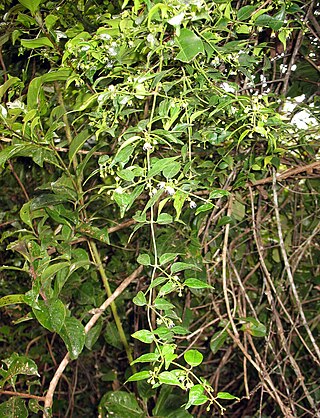
The Asclepiadoideae are a subfamily of plants in the family Apocynaceae. Formerly, it was treated as a separate family under the name Asclepiadaceae, e.g. by APG II, and known as the milkweed family.

Ceropegia is a genus of plants within the family Apocynaceae, native to Africa, southern Asia, and Australia. It was named by Carl Linnaeus, who first described this genus in his Genera plantarum, which appeared in 1737. Linnaeus referred to the description and picture of a plant in the Horti Malabarici as the plant for which the genus was created. In 1753 he named this species as Ceropegia candelabrum. Linnaeus did not explain the etymology but later explanations stated that the name Ceropegia was from the Greek word keropegion κηροπηγɩον. This means candelabrum in Latin, which has a broader range than the modern word - "a candlestick, a branched candlestick, a chandelier, candelabrum, or also lamp-stand, light-stand, sometimes of exquisite workmanship".

Matelea is a genus of flowering plants in the family Apocynaceae. It contains about 200 species, which are commonly known as milkvines. Some people consider Chthamalia to be a synonym to or a subgenus of Matelea.
Gonolobus fimbriatiflorus, synonym Matelea fimbriatiflora, is a species of plant in the family Apocynaceae. It is native to Costa Rica, Nicaragua and Panama in Central America, and Ecuador.

Edithcolea is a monotypic genus with a single species Edithcolea grandis. Once classified in the family Asclepiadaceae, it is now in the subfamily Asclepiadoideae of the dogbane family Apocynaceae. It is native to eastern Africa and to the Arabian Peninsula.
Matelea lanata, synonym Trichosacme lanata, is a species of plants in the family Apocynaceae native to northeastern Mexico. When placed in the genus Trichosacme, it was the only species.

Fockea multiflora, or python vine, is a plant of the dogbane family, Apocynaceae, native to Tanzania, Mozambique, Zimbabwe, Zambia, Angola, Botswana, Namibia, including the Caprivi Strip, and Malawi. It is a large semisucculent liana, growing to some 15m in length and up to 60 cm in diameter, found primarily in the seasonally dry tropical biome.
Chthamalia is a genus of flowering plants in the dogbane family. The genus was first formally named in 1844. It contains approximately 10 to 15 species native to Mexico and the southern United States. Chthamalia is accepted as a genus by Plants of the World Online, but is considered by others to be a synonym or a subgenus of Matelea.
Leichhardtia mackeeorum, synonym Marsdenia mackeeorum, is a species of vine in the family Apocynaceae. It is endemic to New Caledonia.

Dischidia hirsuta is a species of plant in the genus Dischidia. It is widely distributed in Southeast Asia from Thailand through Vietnam, Indonesia, the Philippines and continuing to the Solomon Islands. It grows as an epiphyte and its name refers to its often hirsute foliage covered in fine hairs, though the species has variable foliage and flowers throughout its range. Its succulent leaves may be lanceolate to more rounded, and are sometimes covered with red spots. The flowers range from pale yellow to dark red.

Baroniella linearis is a species of plant in the Apocynaceae family. It is endemic to Madagascar. Pierre Choux, the botanist who first formally described the species using the synonym Baseonema lineare, named it after its narrow leaves.

Buckollia volubilis is a species of plant in the Apocynaceae family. It is native to the Ethiopia, Kenya, Somalia, Tanzania and Uganda. Rudolf Schlechter, the botanist who first formally described the species, named it after its twining growth habit, using the synonymous name Raphionacme volubilis.

Camptocarpus acuminatus is a species of plant in the Apocynaceae family. It is endemic to the Madagascar. Pierre Choux, the botanist who first formally described the species, named it after the tapering tips of its leaves, using the synonymous name Tanulepis acuminata.

Camptocarpus semihastatus is a species of plant in the Apocynaceae family. It is native to Madagascar. Jens Klackenberg, the botanist who formally described the species named it after the distinct coronal lobes of its flowers that resemble half the head of a spear.

Condylocarpon guyanense is a species of plant in the Apocynaceae family. It is native to Brazil, French Guiana, and Guyana. René Louiche Desfontaines, the botanist who first formally described the species, named it after Guyana where Joseph Martin collected the specimen he examined.
Orinoquia yanomamica is a species of flowering plant in the dogbane family, Apocynaceae. It is a climber endemic to Amazonas state of southern Venezuela. It is the sole species in genus Orinoquia. The species was first named Matelea yanomamica by Gilberto Morillo in 1981. In 2015 Morillo moved the species to its own genus.
Graciemoriana gracieae is a species of flowering plant in the dogbane family, Apocynaceae. It is the sole species in genus Graciemoriana. It is endemic to French Guiana.
Peruviasclepias aliciae is a species of flowering plant in the dogbane family, Apocynaceae. It is the sole species in genus Peruviasclepias. It is a climber endemic to Peru.
Riparoampelos amazonicus is a species of flowering plant in the dogbane family, Apocynaceae. It is the sole species in genus Riparoampelos. It is a climber native the Amazon Rainforest of southeastern Colombia, Amazonas state of southern Venezuela, eastern Peru, and northwestern Brazil.
Chthamalia pubiflora, the trailing milkvine or sandhill spiny pod, is a species of flowering plant in the Apocynaceae family, native to southeastern Georgia and peninsular Florida. It is in the Asclepiadaceae (milkweed) subfamily. A perennial vine, it has reddish-brown or light green flowers. The petals have long white hairs on them.









